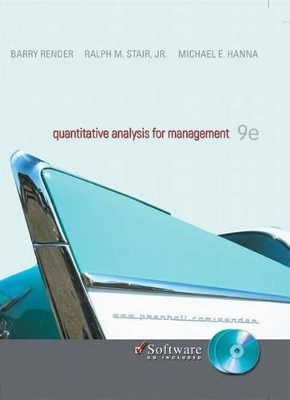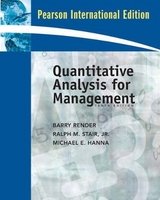
Quantitative Analysis for Management with CD
Pearson
978-0-13-185702-5 (ISBN)
- Titel erscheint in neuer Auflage
- Artikel merken
Intended for courses in Management Science or Quantitative Methods.
This best-selling text has long been considered one of the most student accessible texts for the management science course. The new edition retains and updates the traditional, comprehensive coverage of past editions but “fine tunes” the coverage and adds many new examples and exercises.
1. Introduction to Quantitative Analysis
Introduction. What Is Quantitative Analysis? The Quantitative Analysis Approach. How to Develop a Quantitative Analysis Model.
The Role of Computers and Spreadsheet Models in the Quantitative Analysis Approach. Possible Problems in the Quantitative Analysis
Approach. Implementation—Not Just the Final Step
2. Probability Concepts and Applications
Introduction. Fundamental Concepts. Mutually Exclusive and Collectively Exhaustive Events. Statistically Independent Events.
Statistically Dependent Events. Revising Probabilities with Bayes’ Theorem. Further Probability Revisions. Random Variables.
Probability Distributions. The Binomial Distribution. The Normal Distribution. The Exponential Distribution. The Poisson Distribution.
3. Decision Models and Decision Trees
Introduction. The Six Steps in Decision Making. Types of Decision-Making Environments. Decision Making under Uncertainty.
Decision Making under Risk. Decision Trees. How Probability Values Are Estimated by Bayesian Analysis. Utility Theory.
4. Regression Models
Introduction. Scatter Diagrams. Simple Linear Regression. Measuring the Fit of the Regression Model. Assumptions of the Regression
Model. Testing the Model for Significance. Multiple Regression Analysis. Binary or Dummy Variables. Model Building. Nonlinear
Regression. Cautions and Pitfalls in Regression Analysis.
5. Forecasting
Introduction. Types of Forecasts. Scatter Diagrams and Time Series. Measures of Forecast Accuracy. Time-Series Forecasting Models.
Monitoring and Controlling Forecasts. Using the Computer to Forecast.
6. Inventory Control Models
Introduction. Importance of Inventory Control. Inventory Decisions. Economic Order Quantity: Determining How Much to Order
Reorder Point: Determining When to Order. EOQ Without the Instantaneous Receipt Assumption. Quantity Discount Models.
Use of Safety Stock. ABC Analysis. Dependent Demand: The Case for Materials Requirements Planning. Just-In-Time Inventory Control.
Enterprise Resource Planning.
7. Linear Programming Models: Graphical and Computer Methods
Introduction. Requirements of a Linear Programming Problem. Formulating LP Problems. Graphical Solution to a LP Problem. Solving Flair
Furniture’s LP Problem Using QM for Windows and Excel. Solving Minimization Problems. Four Special Cases in LP. Sensitivity Analysis.
8. Linear Programming Modeling Applications and Computer Analyses
Introduction. Marketing Applications. Manufacturing Applications. Employee Scheduling Applications. Financial Applications. Transportation
Applications. Transshipment Applications. Ingredient Blending Applications.
9. Linear Programming: The Simplex Method
Introduction. How to Set Up the Initial Simplex Solution. Simplex Solution Procedures. The Second Simplex Tableau Developing the Third
Tableau. Review of Procedures for Solving LP Maximization Problems. Surplus and Artificial Variables Solving Minimization Problems.
Review of Procedures for Solving LP Minimization Problems. Special Cases.Sensitivity Analysis with the Simplex Tableau. The Dual.
Karmarkar’s Algorithm.
10. Transportation and Assignment Models
Introduction. Setting Up a Transportation Problem. Developing an Initial Solution: Northwest Corner Rule. Stepping-Stone Method:
Finding a Least-Cost Solution. MODI Method. Vogel’s Approximation Method: Another Way to Find an Initial Solution. Unbalanced
Transportation Problems. Degeneracy in Transportation Problems. More Than One Optimal Solution. Unacceptable or Unacceptable or
Prohibited Routes. Facility Location Analysis. Approach of the Assignment Model. Unbalanced Assignment Problems. Maximization
Assignment Problems
11. Integer Programming, Goal Programming, and Nonlinear Programming
Introduction. Integer Programming. Modeling with 0–1 Variables. Goal Programming. Nonlinear Programming.
12. Network Models
Introduction. Minimal-Spanning Tree Technique. Maximal-Flow Technique. Shortest-Route Technique.
13. Project Management
Introduction. PERT. PERT/Cost. Critical Path Method. Other Topics in Project Management.
14. Waiting Lines and Queuing Theory Models
Introduction. Waiting Line Costs. Characteristics of a Queuing System. Single-Channel Queuing Model with Poisson Arrivals and
Exponential Service Times (M/M/1). Multiple-Channel Queuing Model with Poisson Arrivals and Exponential Service Times (M/M/m).
Constant Service Time Model (M/D/1). Finite Population Model (M/M/1 with Finite Source). Some General Operating Characteristic
Relationships. More Complex Queuing Models and the Use of Simulation
15. Simulation Modeling
Introduction. Advantages and Disadvantages of Simulation. Monte Carlo Simulation. Simulation and Inventory Analysis. Simulation of a
Queuing Problem. Fixed Time Increment and Next Event Increment Simulation Models. Simulation Model for a Maintenance Policy.
Two Other Types of Simulation Models. Verification and Validation. Role of Computers in Simulation.
16. Markov Analysis
Introduction. States and State Probabilities. Matrix of Transition Probabilities. Predicting Future Market Shares. Markov Analysis
of Machine Operations. Equilibrium Conditions. Absorbing States and the Fundamental Matrix: Accounts Receivable Application.
17. Statistical Quality Control
Introduction. Defining Quality and TQM. Statistical Process Control. Control Charts for Variables. Control Charts for Attributes.
Appendices
CD-ROM Modules
| Erscheint lt. Verlag | 5.5.2005 |
|---|---|
| Sprache | englisch |
| Gewicht | 1552 g |
| Themenwelt | Mathematik / Informatik ► Mathematik ► Finanz- / Wirtschaftsmathematik |
| Wirtschaft ► Betriebswirtschaft / Management ► Unternehmensführung / Management | |
| ISBN-10 | 0-13-185702-9 / 0131857029 |
| ISBN-13 | 978-0-13-185702-5 / 9780131857025 |
| Zustand | Neuware |
| Haben Sie eine Frage zum Produkt? |
aus dem Bereich



